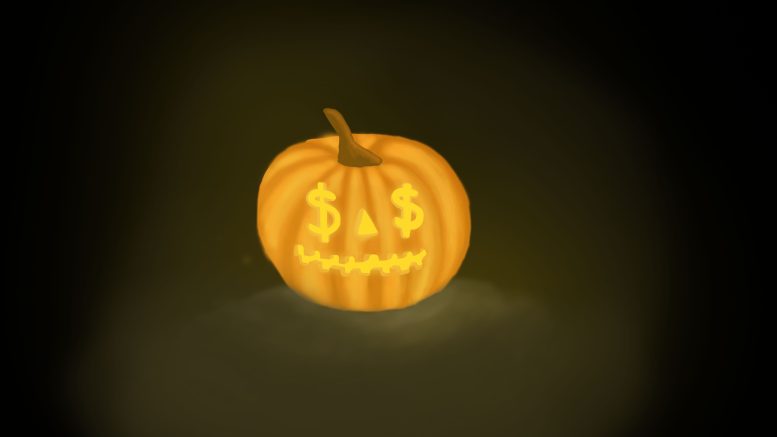Let us begin by saying that this is not a Halloween hit piece. We genuinely enjoy the
holiday.
When Braden was younger, he was far from a Halloween fan. It overshadowed his
birthday, and having asthma made it difficult to wander around in the cold for five hours
begging for free candy. But he still enjoyed Halloween, especially as an excuse to spend
time with friends and see how excited so many people got over it.
Much like Braden, Dina likes Halloween too. It is the only major commercial holiday that is
celebrated in her house. For that reason, growing up she was a big fan and supporter of
Halloween. She loved the fact that she could dress up to her heart’s desire and get free
candy. Sadly, she is no longer able to partake in the free sweet festivities. Instead, she lives
vicariously through her younger siblings and steals their candy.
Despite this happy compromise, it is hard not to get caught up in the whirlwind of spending
that is needed to celebrate. Halloween is an incredibly commercialized holiday. Despite
finding its roots in the Celtic pagan festival of Samhain and the Christian holiday All Hallows’
Eve, Halloween has been co-opted by corporations. The season is ripe with advertisements
for movies like Halloween Ends, with a trailer that boasts over 11 million views. Items like a
$55 Among Us costume for kids drive the commercialization further.
Advertisements and products like this are indicative of the Halloween profit surge. The
National Retail Federation (NRF) estimates that US$10.6 billion will be spent by American
consumers during the 2022 Halloween season. In contrast, the NRF estimated that
Americans would spend around US$6.9 billion on Halloween in 2015.
As an example, we could look at a Winnipeg family interested in handing out candy and
purchasing three Halloween costumes for their kids.
For 200 snack-size Nestlé chocolate bars, one could expect to pay over $38 without any
discounts. For three kids costumes, before tax you could be paying $39.99 for a Mirabel
costume from Disney’s Encanto, $44.99 for a Buzz Lightyear costume from Disney’s
Lightyear and $34.99 for a Grim Reaper costume.
This brings the total to over $155, and that isn’t even counting decorations or any other
expenses that one could happily incur at their local supermarket or online retailer.
In 2020, due to the COVID-19 pandemic and the strict social-distancing rules in place
through October, Halloween was basically cancelled.
When we reflect on the last two years of the pandemic, we can see that despite the new
challenges brought on by COVID-19, it did not take long before solutions were found to allow
the commercialism of Halloween to return.
After the lacking Halloween of the previous year, the celebrations for 2021 came out in full
force. Halloween goers once more filled the streets of the city, as 82 per cent of eligible
Manitobans were fully vaccinated by Oct. 21, 2021.
Despite the high vaccination rates, public health orders and restrictions were still in effect
during this time.
As a result, we had to reshape the way we celebrated the spooky season, not for the
millions of people and children that excitedly look forward to Halloween, but to protect and
preserve this billion-dollar industry.
It is not in the best interests of manufacturers of candy, costumes and decorations,
retailers, pumpkin farmers, make-up companies and dentists if we do not all celebrate
Halloween together.
For that reason, companies and corporations have had to severely pivot and adapt to
ensure that they bring in the largest amount of revenue over the holiday season. This has
led to the development of new and creative ways to keep the Halloween spirit alive in order
to encourage consumer spending.
For example, haunted attractions have developed new and safe protocols to scare people
while adhering to COVID-19 guidelines. This resulted in the popularization of haunted drive-
throughs, and in a similar manner, trick-or-treat drive-through events have also become
more common, with Grant Park Shopping Centre hosting one just last year.
In addition to organizing and hosting contactless events, companies have even introduced
new Halloween-themed products to generate more income, such as Tim Hortons with its
new Trick-or-Treat Bucket stuffed with Timbits.
Now, even if you are unable to go trick-or-treating you can still get a bucket of treats
without the hassle of walking and begging, just for a small price. We can always count on
capitalistic greed to persevere in the face of many challenges.
From the top down, the holiday may end up oriented around purchasing candy and buying
costumes from licensed properties. Halloween is not alone in this though, as Christmas is
notorious for consumer spending. This Christmas, Canadians are expected to spend around
$1,520 per household. This begs the question: what is to be done about this?
Realistically, it is unfair to refuse to give your kids a Halloween experience because it is
too corporate, but you could change the way you orient the holiday. Rather than head to
Spirit Halloween, you could take the time to put together costumes at home, go thrift
shopping or use hand-me-down costumes.
Instead of going to see the latest blockbuster, you could sit around watching box office
bombs or underappreciated Halloween classics. And instead of heading to the store to buy
candy from wealthy corporations such as Walmart, which brought in $573 billion in revenue
during the 2022 fiscal year alone, you could buy from small businesses or bake your own
treats.
The joy of Halloween does not have to come from a costume bought at Spirit Halloween or
candy from Walmart. Halloween spirit can come from the time we spend together at corn
mazes, watching old DVDs, carving pumpkins and making treats that are probably really bad
for you.





